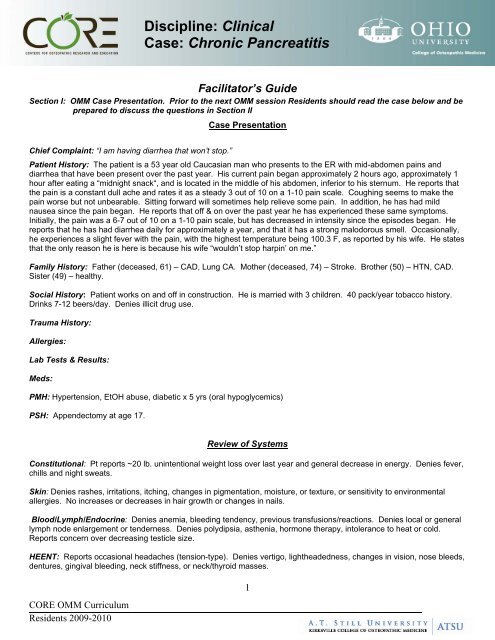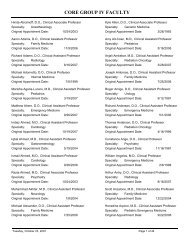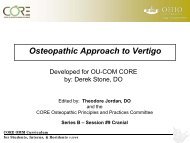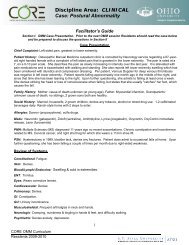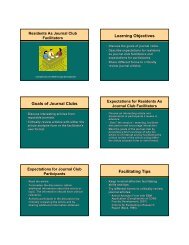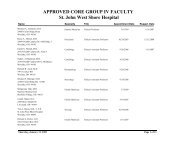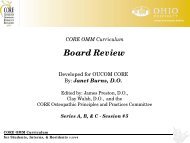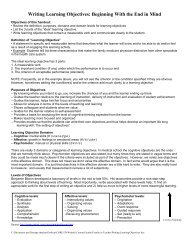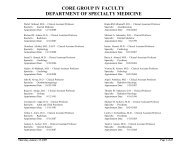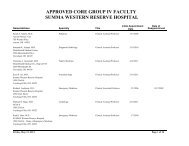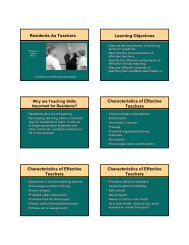Clinical Case: Chronic Pancreatitis
Clinical Case: Chronic Pancreatitis
Clinical Case: Chronic Pancreatitis
You also want an ePaper? Increase the reach of your titles
YUMPU automatically turns print PDFs into web optimized ePapers that Google loves.
Discipline: <strong>Clinical</strong><br />
<strong>Case</strong>: <strong>Chronic</strong> <strong>Pancreatitis</strong><br />
Facilitator’s Guide<br />
Section I: OMM <strong>Case</strong> Presentation. Prior to the next OMM session Residents should read the case below and be<br />
prepared to discuss the questions in Section II<br />
<strong>Case</strong> Presentation<br />
Chief Complaint: “I am having diarrhea that won’t stop.”<br />
Patient History: The patient is a 53 year old Caucasian man who presents to the ER with mid-abdomen pains and<br />
diarrhea that have been present over the past year. His current pain began approximately 2 hours ago, approximately 1<br />
hour after eating a “midnight snack“, and is located in the middle of his abdomen, inferior to his sternum. He reports that<br />
the pain is a constant dull ache and rates it as a steady 3 out of 10 on a 1-10 pain scale. Coughing seems to make the<br />
pain worse but not unbearable. Sitting forward will sometimes help relieve some pain. In addition, he has had mild<br />
nausea since the pain began. He reports that off & on over the past year he has experienced these same symptoms.<br />
Initially, the pain was a 6-7 out of 10 on a 1-10 pain scale, but has decreased in intensity since the episodes began. He<br />
reports that he has had diarrhea daily for approximately a year, and that it has a strong malodorous smell. Occasionally,<br />
he experiences a slight fever with the pain, with the highest temperature being 100.3 F, as reported by his wife. He states<br />
that the only reason he is here is because his wife “wouldn’t stop harpin’ on me.”<br />
Family History: Father (deceased, 61) – CAD, Lung CA. Mother (deceased, 74) – Stroke. Brother (50) – HTN, CAD.<br />
Sister (49) – healthy.<br />
Social History: Patient works on and off in construction. He is married with 3 children. 40 pack/year tobacco history.<br />
Drinks 7-12 beers/day. Denies illicit drug use.<br />
Trauma History:<br />
Allergies:<br />
Lab Tests & Results:<br />
Meds:<br />
PMH: Hypertension, EtOH abuse, diabetic x 5 yrs (oral hypoglycemics)<br />
PSH: Appendectomy at age 17.<br />
Review of Systems<br />
Constitutional: Pt reports ~20 lb. unintentional weight loss over last year and general decrease in energy. Denies fever,<br />
chills and night sweats.<br />
Skin: Denies rashes, irritations, itching, changes in pigmentation, moisture, or texture, or sensitivity to environmental<br />
allergies. No increases or decreases in hair growth or changes in nails.<br />
Blood/Lymph/Endocrine: Denies anemia, bleeding tendency, previous transfusions/reactions. Denies local or general<br />
lymph node enlargement or tenderness. Denies polydipsia, asthenia, hormone therapy, intolerance to heat or cold.<br />
Reports concern over decreasing testicle size.<br />
HEENT: Reports occasional headaches (tension-type). Denies vertigo, lightheadedness, changes in vision, nose bleeds,<br />
dentures, gingival bleeding, neck stiffness, or neck/thyroid masses.<br />
CORE OMM Curriculum<br />
Residents 2009-2010<br />
1
Discipline: <strong>Clinical</strong><br />
<strong>Case</strong>: <strong>Chronic</strong> <strong>Pancreatitis</strong><br />
Cardiovascular: Denies precordial and substernal pain, palpitations, syncope, dyspnea on exertion, orthopnea, nocturnal<br />
paroxysmal dyspnea, edema, cyanosis, varicosities, phlebitis or claudication.<br />
Pulmonary: Admits to constant “smoker’s cough.” Denies SOB, wheezing, stridor, hemoptysis, infections, or TB/TB<br />
exposures.<br />
GI: Positive for decrease in appetite. Pain increased with eating large meals. Mild dyspepsia. Some nausea with<br />
abdominal pain. Denies vomiting, hematemesis, jaundice, and constipation. Describes stools as clay-colored, greasy,<br />
and malodorous. Denies hemorrhoids.<br />
UG: Denies urinary urgency or frequency, dysuria, nocturia, hematuria, polyuria, oliguria, unusual color of urine, stones,<br />
infections, hesitancy, change in stream, or problems with retention/incontinence. Denies changes in libido or any penile<br />
discharge.<br />
GYN: N/A<br />
Musculoskeletal: Denies pain, swelling, redness or heat of muscles or joints.<br />
Denies limitation of motion, muscular weakness, atrophy, or cramps.<br />
Neurologic: Denies convulsions, paralyses, tremor. Reports occasional<br />
balance problems, paresthesias in toes. Denies difficulties with memory or<br />
speech.<br />
Psychiatric: Denies psychiatric problems/care, hallucinations, anxiety,<br />
depression.<br />
OMM Focused Structural Exam<br />
Bogginess at the OA, C1, and C2 tissues, left<br />
more than right. OA FSrRl, C2 RlSl, C5<br />
FSrSl.<br />
Reduced thoracic kyphosis and lumbar<br />
lordosis. He has bilateral paravertebral<br />
spasm, especially T5-9.<br />
Articular restriction is greatest T6-9. T7<br />
ESrRr, T11 FSlRl.<br />
Physical Exam<br />
Vital signs: Temp. 99.2 F, BP 152/96, RR 22, P 90<br />
General: Patient is in mild distress. Body habitus is thin with temporal wasting.<br />
HEENT-<br />
Head: Atraumatic, normocephalic,<br />
Assessment:<br />
Eyes: Conjunctiva clear; pupils 3 mm in size, EOMI, PERLLA<br />
Ears: Tympanic membranes are pearly gray; no TM inflammation or perforation.<br />
Nose: Normal appearing nasal turbinates; septum midline<br />
Throat:No pharyngeal erythema; there are no pustules, ulcers<br />
or exudate.<br />
Face: Symmetric; no maxillary or frontal sinus tenderness<br />
Neck: Supple, no anterior or posterior cervical lymphadenopathy; thyroid is not palpable; trachea is midline; no JVD<br />
Heart: Regular rhythm; normal S1 and S2; no S3 or S4; no murmurs, gallops or rubs.<br />
Lungs: Scattered rhonchi.<br />
Abdomen: Tenderness to palpation over the mid-abdomen, inferior to the sternum, and slightly to the left in the left upper<br />
quadrant. Somewhat rigid in these same areas. Non-distended. BS present but hypoactive.<br />
Extremities: Two ulcerations located on the plantar aspect of the left foot and one ulceration located on the plantar<br />
aspect of the right foot, in early stages of healing. No clubbing or cyanosis. Increased erythema in all lower extremity<br />
digits. Femoral and popliteal pulse 2+ bilaterally. Dorsalis pedis and posterior tibialis pulses 1+ bilaterally. Decreased<br />
hair growth on toes. All nails show yellowing and thickening, suggesting onychomycosis.<br />
2<br />
CORE OMM Curriculum<br />
Residents 2009-2010<br />
Tissue texture changes in 7 th intercostal<br />
space on the right at the costochondral<br />
junction and over the celiac ganglion.<br />
Thoracic inlet was ESlRl. The thorax has<br />
general restriction to exhalation. The<br />
diaphragm was extremely tense and<br />
depressed with reduced excursion.
Discipline: <strong>Clinical</strong><br />
<strong>Case</strong>: <strong>Chronic</strong> <strong>Pancreatitis</strong><br />
Neuro: Positive Romberg’s test. DTRs 2/4 bilaterally in all extremities. Decreased sensation in bilateral feet, most<br />
severe at digits and decreasing in intensity proximally.<br />
GU:<br />
Bilaterally descended testes with atrophic changes.<br />
Section II: Focus of the <strong>Case</strong> (approximate time 20–30 minutes)<br />
Discussion Questions<br />
1. Propose an appropriate differential<br />
diagnosis / assessment<br />
1. continued<br />
2. What is your final diagnosis?<br />
Differential Diagnoses:<br />
<strong>Pancreatitis</strong> – acute vs. chronic<br />
Gastric cancer<br />
Cholangitis<br />
Cholecystitis<br />
Cholelithiasis<br />
Gastritis, chronic<br />
Peptic ulcer disease<br />
GERD<br />
Crohn’s Disease<br />
Mesenteric artery ischemia<br />
Liver failure<br />
Pancreatic pseudocyst<br />
Paraneoplastic syndrome<br />
<br />
<br />
<br />
Teaching Points<br />
Primary Diagnosis: <strong>Chronic</strong> <strong>Pancreatitis</strong><br />
Secondary Diagnosis: Steatorrhea, Alcoholism, Hypertension<br />
Somatic dysfunction related to diagnosis: thoracic, cervical,<br />
diaphragm<br />
CORE OMM Curriculum<br />
Residents 2009-2010<br />
3
Discipline: <strong>Clinical</strong><br />
<strong>Case</strong>: <strong>Chronic</strong> <strong>Pancreatitis</strong><br />
3. How do you explain the current<br />
structural findings in the context of<br />
this case?<br />
<br />
<br />
<br />
Are any relevant structural findings<br />
missing?<br />
What would you do differently?<br />
Why?<br />
4. What pathophysiology & functional<br />
anatomy knowledge is pertinent for<br />
diagnosing/treating this patient<br />
5. What will be your highest yield<br />
regions?<br />
6. How does previous trauma influence<br />
these regions?<br />
Sympathetic viscerosomatic reflexes for the pancreas are found at T5-9<br />
bilaterally while the parasympathetic viscerosomatic reflexes are found<br />
between the occiput and C2 bilaterally. In the more chronic cases of<br />
pancreatitis tend put the thoracic spine into a relative extension through<br />
the T5-9 segments.<br />
Further visceral and viscerosomatic changes in the form of Chapman’s<br />
reflexes and celiac ganglion tension are found in the right 7 th intercostal<br />
space and midline several cm beneath the xiphoid, respectively.<br />
Considering his comorbid condition of EtOH abuse, it is likely there are<br />
visceral changes related to his liver and possibly other GI structures.<br />
These are found in the same distribution as the above mentioned<br />
regions.<br />
The pancreas is not encapsulated & therefore inflammation spreads<br />
easily. Its corresponding spinal level through the sympathetic nervous<br />
system is T5-9 and parasympathetic supply comes from the vagus nerve.<br />
Pancreatic cells can be destroyed by EtOH, thereby destroying their ability<br />
to produce necessary hormones for digestion, which also causes a<br />
decrease in the intensity of abdominal pain during flare-ups. The<br />
decrease in digestive enzymes also causes a decrease in nutrient<br />
absorption, resulting in weight loss and an increase of fat in stools.<br />
Insulin-producing pancreatic beta cells and glucagons-producing alpha<br />
cells can also be injured, causing pancreatic diabetes. EtOH abuseinduced<br />
cell injury also causes the release of cytokines which increase<br />
collagen and therefore fibrosis of the pancreas. Hypertension, resulting in<br />
ischemia, can exacerbate the ischemia caused by the ductal obstruction<br />
and fibrosis. Finally, pancreatic diabetes usually cannot be treated with<br />
oral hypoglycemics, but only with insulin. This causes a problem as<br />
glucagon is also decreased, and may result in a hypoglycemic coma if<br />
blood sugar is not well-controlled<br />
Thoracic region is highest yield to decrease sympathetics, followed by<br />
abdominal region to release tensions on the pancreas.<br />
Comorbidity of tobacco abuse may require more attention to the<br />
lungs/diaphragm.<br />
The patient has no trauma history listed but even minor traumas could<br />
have resulted in fascial restrictions, especially through the abdomen<br />
and respiratory diaphragm. This would affect venous and lymphatic<br />
return<br />
7. Which 1 or 2 of the aspects below has<br />
the greatest influence on the patient<br />
complaint?<br />
Pain<br />
Fluid congestion<br />
Hyper-sympathetic influence<br />
Parasympathetic influence<br />
Pain (primary complaint)<br />
Hyper-sympathetic (viscerosomatic reflexes to T5-9 setting up facilitated<br />
segments)<br />
HTN will be negatively influenced with hyper-sympathetic influence.<br />
CORE OMM Curriculum<br />
Residents 2009-2010<br />
4
Discipline: <strong>Clinical</strong><br />
<strong>Case</strong>: <strong>Chronic</strong> <strong>Pancreatitis</strong><br />
8. What are the acute or chronic aspects? Acute – pain<br />
<strong>Chronic</strong> – wasting secondary to malabsorption (pancreatic insufficiency)<br />
and pain (decreasing appetite). Also risking progression to complete<br />
pancreatic failure (diabetes mellitus) as well as liver and other organ<br />
damage secondary to alcohol abuse.<br />
9. Devise an appropriate treatment plan<br />
based on musculoskeletal components<br />
involved in the patient complaint<br />
Goals for osteopathic manipulative management—includes:<br />
1. Reduce somatic dysfunction of T5-9 to decrease somatic contribution<br />
to the facilitated spinal cord segments.<br />
2. Improve general function of the nervous system (especially decrease<br />
sympathetic tone)<br />
3. Reduce fascial restrictions in the abdomen, as well as associated<br />
venous and lymphatic structures.<br />
4. Improve abdominal diaphragm excursion<br />
The treatment plan could include:<br />
1. Paraspinal inhibition<br />
2. Muscle energy to thoracic segments<br />
3. Normalize parasympathic influence through suboccipital release<br />
4. Visceral techniques to pancreas<br />
Myofascial release to abdomen and diaphragm<br />
10. How soon would you see the patient<br />
for OMM follow-up?<br />
11. What are the outpatient, inpatient, and<br />
emergency room considerations?<br />
Most important is to decrease facilitation of the thoracic segments<br />
however attention must also be paid to the patient’s systemic tolerance of<br />
treatment. This may require shorter, gentler techniques with greater<br />
frequency at first (more than once daily) and then decreasing as<br />
facilitation starts to resolve and patient reserves are improved.<br />
In the emergency room, the patient’s primary complaint of pain needs to<br />
be addressed. OMM can and should be offered in a gentle and cautious<br />
manner. Paraspinal inhibition is the modality to offer first followed by<br />
gentle thoracic treatment as tolerated. If his pain is bad<br />
enough/intractable, he may be admitted in whereupon he should receive<br />
regular but conservative treatments. Somewhere in his management<br />
treatment for alcohol cessation needs to be implemented, either as an inor<br />
outpatient. Outpatient follow-up will definitely be needed for both<br />
continued OMM and most importantly, treatment/counseling of his chronic<br />
and progressive pancreatitis.<br />
12. How are you going to talk to your<br />
patient about their complaint and your<br />
treatment?<br />
13. How will you communicate your<br />
findings, diagnosis, and rationale for OMM<br />
treatment to your preceptor?<br />
In a confident, even tone, laymen's terms. Convey the seriousness of the<br />
situation.<br />
I will present the patient’s findings in a systematic manner<br />
CORE OMM Curriculum<br />
Residents 2009-2010<br />
5
Discipline: <strong>Clinical</strong><br />
<strong>Case</strong>: <strong>Chronic</strong> <strong>Pancreatitis</strong><br />
14. What coding and billing information for<br />
evaluation and management and<br />
procedural services will you generate?<br />
15. How would you record your encounter<br />
and OMT on your patient care logs?<br />
E/M—Emergency Department—Detailed 99284<br />
Procedure—Manipulation, 3-4 areas<br />
Diagnoses<br />
<strong>Chronic</strong> <strong>Pancreatitis</strong> 577.1<br />
Diabetes Mellitus 250<br />
Alcoholism V11.3<br />
Hypertension 401<br />
Tobacco Abuse 305.1<br />
Somatic Dysfunction-Abdomen 739.9, Cervical 739.1, Thoracic 739.2<br />
Enter patient data, diagnosis date, and any special comments.<br />
Procedure Services:<br />
Osteopathic Manipulative Treatment<br />
Code<br />
Description<br />
98925 Manipulation, 1-2 areas<br />
98926 Manipulation, 3-4 areas<br />
98927 Manipulation, 5-6 areas<br />
98928 Manipulation, 7-8 areas<br />
98929 Manipulation, 9-10 areas<br />
CPT Diagnostic Codes: Rank in order of Importance<br />
Diagnosis<br />
Somatic Dysfunction<br />
Code Description Code Description Code Description<br />
16. What is the Evidence Base?<br />
739.0 Head 739.5 Hip/Pelvis<br />
739.1 Cervical 739.6 Lower<br />
Extremity<br />
739.2 Thoracic 739.7 Upper<br />
Extremity<br />
739.3 Lumbar 739.8 Rib<br />
739.4 Sacrum/Sacroiliac 739.9 Abdomen<br />
*Beal, MC. Viscerosomatic reflexes: a review. JAOA 1985(12):53-68.<br />
*Brown, A, Hughes, M, Tenner, S, Banks, PA. Does pancreatic enzyme supplementation reduce pain in patients with chronic<br />
pancreatitis: a meta-analysis. Am J Gastroenterol 1997; 92:2032.<br />
*Ettlinger, H. Treatment of the Acutely Ill Hospitalized Patient. In: Ward RC, ed. Foundations for Osteopathic Medicine. 2 nd<br />
ed. Philadelphia: Lippincott Williams & Wilkins, 2002;1115-1142.<br />
*Nelson, KE, Glonek, T. Somatic Dysfunction in Osteopathic Family Medicine, Lippincott Williams & Wilkins, 2007;296-298.<br />
*Steer, ML, Waxman, I, Freedman, SD. <strong>Chronic</strong> pancreatitis. N Engl J Med 1995; 332:1482.<br />
*Singh, VV, Toskes, PP. Medical therapy for chronic pancreatitis pain. Curr Gastroenterol Rep. 2003; 5:110.<br />
CORE OMM Curriculum<br />
Residents 2009-2010<br />
6
Discipline: <strong>Clinical</strong><br />
<strong>Case</strong>: <strong>Chronic</strong> <strong>Pancreatitis</strong><br />
*Talamini G, et al: Alcohol and smoking as risk factors in chronic pancreatitis and pancreatic cancer. Dig Dis Sci 1999 Jul;<br />
44(7): 1303-11.<br />
Search for the best evidence references:<br />
An appraisal of the osteopathic literature is critical to ensure the osteopathic paradigm is foremost in the philosophical<br />
application of information to patient care. Search of relevant and associated data from the osteopathic literature:<br />
OstMed-Dr (http://www.ostmed-dr.com:8080/vital/access/manager/Index)<br />
<br />
<br />
<br />
<br />
Other literature bases (systems or synopsis engines):<br />
Poems (www.infopoems.com)<br />
Family Practice Inquiry Network (www.fpin.org)<br />
PubMed<br />
Ovid<br />
Google Scholar<br />
Section III: Workshop/Lab (approximate time 60 minutes)<br />
Facilitator demonstrates the key treatment techniques.<br />
1. Participants divide into groups at the table<br />
2. At each table, discuss and practice the appropriate palpatory diagnosis for this patient<br />
3. Facilitator demonstrates the key treatment techniques:<br />
4. Participants should practice the following techniques on each other:<br />
<br />
<br />
<br />
<br />
<br />
Paraspinal inhibition<br />
Muscle energy to thoracic segments<br />
Normalize parasympathic influence through suboccipital release<br />
Visceral techniques to pancreas<br />
Myofascial release to abdomen and diaphragm<br />
5. At each table, while the techniques are being practices:<br />
a. Identify and practice good body mechanics for the physician and patient in treatment<br />
b. Discuss the treatment plan<br />
c. Discuss what palpatory findings should change on the patient after OMM treatment<br />
6. Documentation<br />
Residents demonstrate an appropriate documentation of this case including findings and treatment here...<br />
CORE OMM Curriculum<br />
Residents 2009-2010<br />
7
Discipline: <strong>Clinical</strong><br />
<strong>Case</strong>: <strong>Chronic</strong> <strong>Pancreatitis</strong><br />
Section IV: Final Wrap-up and Questions/Answers<br />
CORE OMM Curriculum<br />
Residents 2009-2010<br />
8


